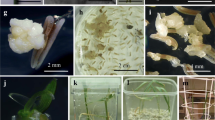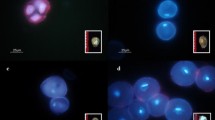Abstract
Timothy (Phleum pratense L.) is an important forage grass grown in northern temperate areas. Development of haploid cell culture techniques for timothy has been limited due to the recalcitrance of timothy in tissue culture. In this study, timothy anther culture techniques were established. Liquid PG-96 (Pulli and Guo, 1996) induction medium significantly promoted embryo yield; the best result was 800–1000 embryos (calli) per 100 anthers. Genotype was an important factor in androgenetic embryogenesis of timothy. Embryos were obtained from 16 genotypes out of the 28 genotypes tested. The optimum stage for microspore development was between the very late uninucleate stage and the binucleate stage. Cold pretreatment applied to the donor plants (spikes) increased embryo yield. Despite a high embryo induction rate, green plant regeneration rate was relatively low. The frequency of albinos was reduced by use of low light intensity conditions during regeneration. Over 300 green plants were recovered.
Similar content being viewed by others
References
Abdullah AA, Pedersen S & Adersen SB (1994) Triploid and hexaploid regenerants from hexaploid timothy (Phleum pratense L.) via anther culture. Plant Breeding 112: 342–345
Anderson JM (1986) Photoregulation of the composition, function, and structure of thylakoid membranes. Ann. Rev. Plant Physiol. 37: 93–136
Cai Q & Bullen MR (1994) Analysis of genome-specific sequences in Phleum species: identification and use for study of genomic relationships. Theor. Appl. Genet. 88: 831–837
Chu CC (1978) The N6 medium and its application to anther culture of cereal crops. In: Proceedings of Symposium on Plant Tissue Culture (p. 43). Science Press, Beijing, China
Chu CC & Hill RD (1988) An improved anther culture method for obtaining higher frequency of pollen embryoids in Triticum aestivum L. Plant Science 55: 175–181
Chuang CC, Ouyang TW, Chia H, Chou SM & Chiang CK (1978) A set of potato medium for wheat anther culture. In: Proceedings of Symposium on Plant Tissue Culture (p. 51). Science Press, Beijing, China
Chuang CC & Jia X (1980) Annual Report of the Institute of Genetics (p. 73). Academia Sinica, Beijing, China
Cistue L, Ziauddin A, Simion E & Kasha KJ (1995) Effects of culture conditions on isolated microspore response of barley cultivar Igri. Plant Cell Tiss. Org. Cult. 42: 163–169
Datta SK & Wenzel G (1987) Isolated microspore derived plant formation via embryogenesis in Triticum aestivum L. Plant Science48: 49–54
Dodds J & Roberts LW (1982) Experiments in plant tissue culture (p. 25). Cambridge University Press, London
Ferrie AMR, Palmer CE & Keller WA (1995) Haploid embryogenesis. In: Thorpe (ed) In Vitro Embryogenesis in Plants (pp. 309–344). Kluwer Academic Publishers, London
George EF (1993) Plant propagation by tissue culture. Part 1, the technology. Exegetics Limited, Edington, England
Guo YD & Pulli S (1996) High-frequency embryogenesis in Brassica campestris microspore culture. Plant Cell Tiss. Org. Cult. 46: 219–225
Hoekstra S, van Zijderveld MH, Louwerse JD, Heidekamp F & van der Mark F (1992) Anther and microspore culture of Hordeum vulgare L. cv. Igri. Plant Science 86: 89–96
Joy RWIV, Patel KR & Thorpe TA (1988) Ascorbic acid enhancement of organogenesis in tobacco callus. Plant Cell Tiss. Org. Cult. 13: 219–228
Kasha KJ (1989) Production of haploids in cereals. In: Maluszynski M (ed) Current Options for Cereal Improvement (pp. 71–80). Kluwer Academic Publishers, London
Kao KN (1981) Plant formation from barley anther cultures with ficoll media. Z. Pflanzenzuchtg. 103: 437–443
Kawata M, Harada S, Antonio B & Oono K (1992) Protoclonal variation of plant regeneration in rice. Plant Cell Tiss. Org. Cult.18: 1–10
Keller ERJ & Korzun L (1996) Ovary and ovule culture for haploid production. In: Mohan Jain S, Sopory SK & Veilleux RE (eds) In Vitro Haploid Production in Higher Plants, Vol 1 (pp. 217–235). Kluwer Academic Publishers, Dordrecht
Knudsen S, Due IK & Anderson SB (1989) Components of response in barley anther culture. Plant Breeding 103: 241–246
Last DJ & Brettell RIS (1990) Embryo yield in wheat anther culture is influenced by the choice of sugar in the culture medium. Plant Cell Rep. 9: 14–16
Liso R, Innoceni AM, Bitonti MB & Arrigoni O (1988) Ascorbic acid-induced progression of quiescent centre cells from G1 to S phase. New Phytol. 110: 469–471
Madsen S, Olesen A, Dennis B & Andersen B (1995) Inheritance of anther-culture response in perennial ryegrass (Lolium perenne L.). Plant Breeding 114: 165–168
Maheshwari SC, Tyagi AK & Malhotra K (1980) Induction of haploidy from pollen grains in angiosperms-the current status. Theor. AppI. Genet. 58: 193–206
Marsolais AA & Kasha KJ (1985) Callus induction from barley microspores. The role of sucrose and auxin in a barley anther culture medium. Can. J. Bot. 63: 2209–2212
Murashige T & Skoog F (1962) A revised medium for rapid growth and bioassays with tobacco tissue cultures. Physiol. Plant 15: 473–497
Niizeki M & Kati F (1973) Studies on plant cell and tissue culture, III. In vitro production of callus from anther culture of forage crops.J. Fac. Agric. Hokkaido Univ.57: 293–300
Ouyang TW (1991) Anther culture in wheat. In: Yan C (ed.) Tissue Culture of Field Crop (pp. 205–222). Shanghai Scientific & Technical Publishers, Shanghai, China
Rakoczy-Trojanowska M, Smiech M & Malepszy S (1997) The influence of genotype and medium on rye (Secale cereale L.) anther culture. Plant Cell Tiss. Org. Cult. 48: 15–21
Sinkovic T & Bohanec B (1988) Chromosome count and karyotype analysis in buckwheat (Fagopyrum esculentum Moench). Fagopyrum 8: 20–22
Wang CC, Sun CS & Chu ZC (1974) On the conditions for the induction of rice pollen plantlets and certain factors affecting the frequency of induction. Acta Botanica Sinica 16: 43–53.
Wang X & Hu H (1984) The effect of potato II medium for Triticale anther culture. Plant Sci. Lett. 36: 237–239
Zhou H, Ball ST & Konzak CF (1992) Functional properties of ficoll and their influence on anther culture responses of wheat. Plant Cell Tiss. Org. Cult. 30: 77–83
Zhu M, Xu A, Yuan M, Huang C, Yu Z, Wang L & Yu J (1990) Effects of amino acid on callus differentiation in barley anther culture. Plant Cell Tiss. Org. Cult. 22: 201–204
Author information
Authors and Affiliations
Rights and permissions
About this article
Cite this article
Guo, YD., Sewón, P. & Pulli, S. Improved embryogenesis from anther culture and plant regeneration in timothy. Plant Cell, Tissue and Organ Culture 57, 85–93 (1999). https://doi.org/10.1023/A:1006392411276
Issue Date:
DOI: https://doi.org/10.1023/A:1006392411276




